Thyme for Tea
OOLONG TEA
Oolong is one of the most enjoyed and popular teas but what exactly is an oolong tea anyways? Oolong, like all teas, comes from the ‘Camellia sinensis’ tea bush and it falls between a green and black tea depending on the method in which the tea leaves are processed. The production of oolong tea requires time-honoured traditions and skillful craftsmanship, it is known as semi-oxidized tea and its the length of the oxidation process that sets a green oolong apart from a black. The oxidation can be from as low as 20% moisture removed (green oolong) up to 80% (black oolong), so its a very difficult tea to manufacture consistently. The method for a for a darker open-leafed oolong is after the tea is picked (3 leaves and a bud) the leaves are withered in the sun for a determined amount of time and then indoors on bamboo baskets, this withering process allows for some of the water in the leaf to evaporate and start the oxidation process. Every two hours the leaves are ‘rattled’, turned and shaken to break the cellular membranes and the outer walls of the leaf, this allows the tea’s special antioxidant qualities to be released into the leaf. When the oxidation reaches the desired level the tea leaves are fired in a hot panning machine and then fully dried in hot ovens to halt the oxidation process. Only a very experienced tea maker knows exactly when to halt oxidation. Another method starts with the withering and turning, but when the leaves reach 30% oxidation the leaves are put through a hot panning machine for 5 to 10 minutes to stop any further oxidation then dried and allowed to rest overnight. The next day they are put in a cloth sacks and formed into 9 kg balls, the balls of tea are put through a special rolling machine to bruise and squeeze the leaves inside. The sacks are then opened and the compact leaves are separated and then wrapped back up. This process of wrapping and unrolling is repeated at least 36 times sometimes up to 60 times until the tea leaves are formed into the little balls that are recognizable as oolong tea. There are about 9000 different oolong teas making it biggest and most diverse tea category, it’s also very healthy and full of disease fighting polyphenols that are released from the leaf cell’s structure during manufacturing. Some famous oolong teas are ‘Phoenix Supreme’, ‘Qing Xiang Dan Cong’, and probably the most famous oolong ‘Ti Kuan Yin’ ( The Iron Goddess of Mercy).
I nice cup of oolong tea, the tea cozy is hand-made by my cousin Sheri
Pinkie’s Up!


Heather, thanks for the great education on Ooolong Tea. I love the tea cozy!
I bought two different oolongs at the San FranciscoTea Festival today. At the Harney & Sons booth, there was a young man named Harney–yep, it’s a grandson. When I asked to smell his oolong, he said oolonbg doesn’t give much of a smell because it’s wound so tightly, that nothing gets out.
James Norwood Pratt was there and he told us that 85 to 90 percent of the tea consumed in USA is iced tea, and the rest if “specialty teas” like those bringing us to the Tea Festival. And with all that iced tea, he said we consume more tea than the UK or Japan. (does iced tea even count??)
Devan Shah gave a Great Teas of India presentation told us but for introducing Chai to the states eight or ten years ago, te would never have made a comeback here. He said it’s harder to pick a good Darjeeling than any other tea. And that one would only stoop to putting milk in the Autumn Flush (4th flush) Darjeeling. I always put milk in my black teas. Have I been tea vulgar?
And Michael Spillane told us that before WWII, only green tea was drunk here. And that after WWII, Lipton & Tetley did a number on us and that’s all we’ll drink now.
This Tea Fest was much smaller than Victoria. Half the size, maybe less. And it was an exciting, beautiful day in The City.
Keep the blogs coming. XOXO W
LikeLike